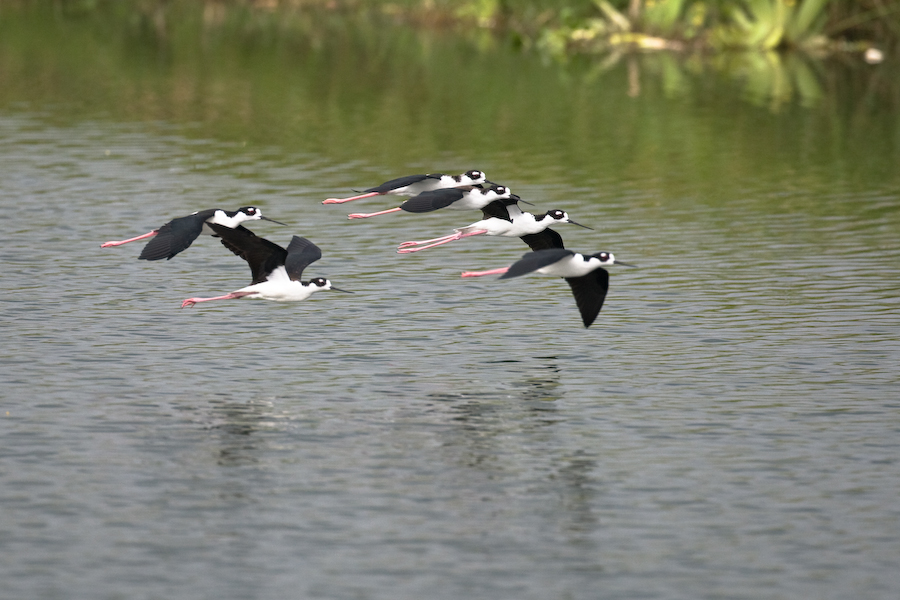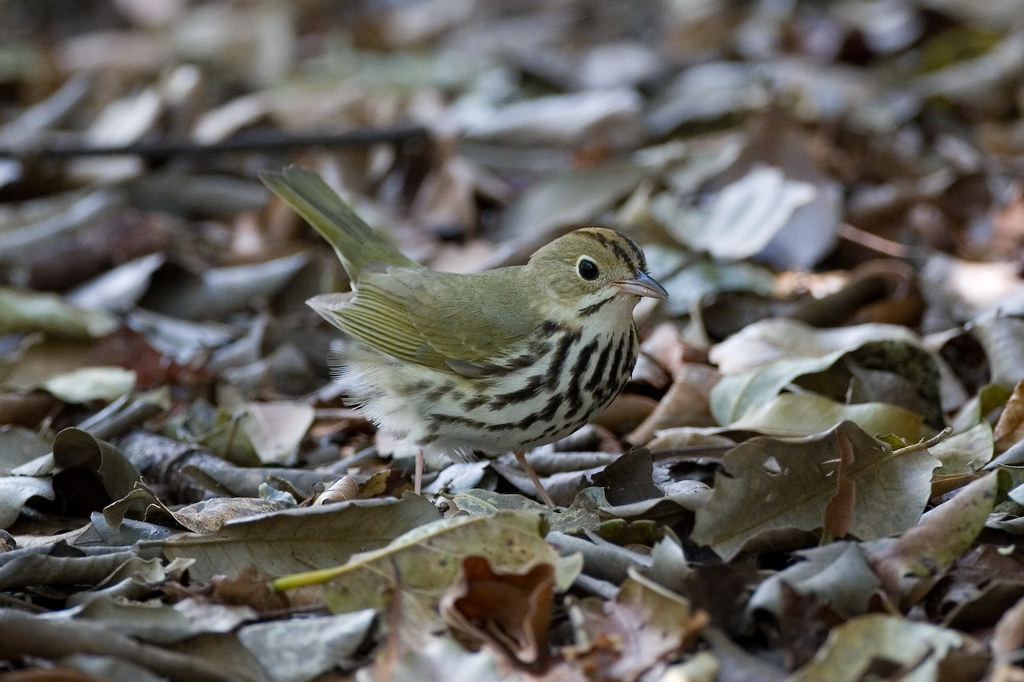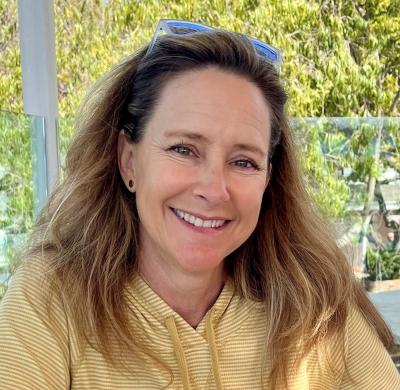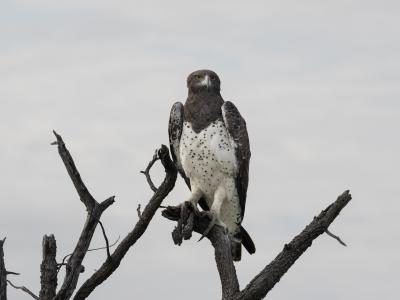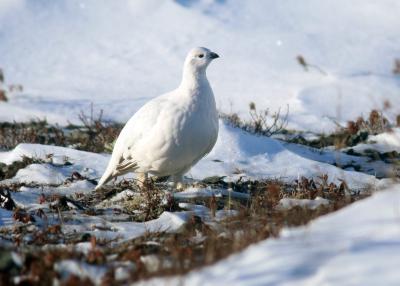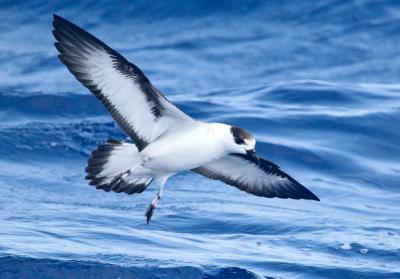Florida: The South, the Keys and the Dry Tortugas
-
Apr 23-30, 2025
Ethan Kistler
-
Apr 25 to May 2 2025
Raymond VanBuskirk
-
Apr 22-29, 2026
Ethan Kistler
2026 Tour Price to be Determined
2026 Tour Price to be Determined
Late April is a wonderful time to visit South Florida. Migrants augment the resident birds, and all of South Florida’s special breeding birds have arrived. We’ll visit the most interesting habitats on the southern end of the peninsula including upland pine forests, the stunning Florida Keys, the Big Cypress Preserve, shallow sandy lagoons of the southwest coast, and the Everglades National Park.
The Keys are at their best at this time of year, and we’ll explore areas known to us looking for the sought-after southern Florida specialties such as Mangrove Cuckoo, Black-whiskered Vireo and White-crowned Pigeon. We’ll also take a day trip to the fabulous Dry Tortugas. Even though we’ll have just four and a half hours on Fort Jefferson, it’s enough time to appreciate the magnificent seabird colony and see most of the birds for which the area is justly famous. On good years the thickets and isolated trees around the fort can be filled with resting migratory birds, an excellent complement to the thousands of Sooty Terns and Brown Noddies wheeling overhead, with the occasional Black Noddy and Bridled Tern. We’ll conclude in the Miami area, where elements of a huge parrot fauna, and several other exotic species have become naturalized. Add in the chance of a vagrant from the Caribbean, and it’s easy to see why South Florida in late April is so appealing.
Day 1: The trip begins at 6 p.m. this evening in the lobby of our hotel near Southwest Florida International Airport, Fort Myers.
Day 2: We’ll leave early for Port Charlotte and the Babcock-Webb Wildlife Management area, a large tract of Slash Pine and marsh whose inhabitants include the celebrated pinewoods trio of Red-cockaded Woodpecker, Brown-headed Nuthatch, and Bachman’s Sparrow. Sandhill Cranes nest in the area, and roadside ditches sometimes hold King Rail. Here too will be singing Eastern Towhees, Brown Thrashers, Eastern Bluebirds and Eastern Meadowlarks, none of which are common further to the south. Just a bit north, on the outskirts of Punta Gorda, several clusters of the curious and social Florida Scrub-Jays have prospered for years and we’re almost certain to find them. It’s hard to know exactly how much time it will take to find and fully absorb these four North American endemics. If we accomplish our goals with dispatch, we may travel further north to the managed wetlands called the Sarasota Celery Fields, where we should encounter our first Limpkin among the many wading birds, and to Fort Desoto, where given the right weather thick woods and fruiting mulberry trees can be filled with migrating songbirds. Nearby the fort we can look for Nanday Parakeets, which reach their peak density around the cities of Tampa and Saint Petersburg. Night in Fort Myers.
Day 3: We’ll start the day visiting a nearby freshwater marsh a few miles inland that typically supports a healthy population of Limpkin and good numbers of Snail Kites that typically forage along the irrigation canals. Afterwards we’ll likely stop in near the coast to look at a colony of Burrowing Owls and then, if the tide conditions favor us, will stop at Bunche Beach; a well-known wader area that supports a nice array of shorebirds and herons at low tide. Later we’ll drive across the peninsula, stopping at the Big Cypress Preserve, a delightful sanctuary with an elevated winding boardwalk through stands of tall Bald Cypress to a sawgrass marsh. The huge Cypress trees lend a somewhat primeval feel, and although the preserve is an experience as much as a birding spot, we hope to find Pileated Woodpecker, and a collection of warblers perhaps including Yellow-throated and Northern Parula on territory. After lunch, we’ll drive south and east across the northern Everglades to Florida City and the gateway to Everglades National Park. If time allows, we’ll visit the neighborhood around the Kendall Baptist Hospital to look for Red-whiskered Bulbul, Spot-breasted Oriole and Egyptian Geese and Muscovy Duck. Night in Florida City.
Day 4: On day four we will visit the Everglades National Park, spending the morning on the main park road into Flamingo, stopping at such well-known places as Anhinga Trail, where the common glades residents are often just a few feet off the boardwalk, and Mahogany Hammock with its collection of tropical hardwood trees, colorful land snails, and often a collection of migrant warblers. At Flamingo, we’ll scan mudflats for shorebirds and terns, possibly including Marbled Godwit and Gull-billed Tern along with the local “Great White” Herons. among many others. Eco Pond, a few hundred feet from the end of the road, has a small island favored by roosting waterbirds often including Roseate Spoonbill and White Ibis, and the pond itself often has a surprise or two. For the past several years small numbers of Shiny Cowbirds have frequented the parking lot area, and with luck we’ll have excellent views of this scarce invader from the Caribbean. With real luck we may also encounter an American Crocodile or West Indian Manatee lurking around Florida Bay.
We’ll return to Florida City midday, then make the incredibly scenic, if slow, 120-mile drive to Key West, making a few stops along the way before arriving in the late afternoon. We’ll eat dinner early, then venture out again at dusk to look for and listen to Antillean Nighthawk. Night in Key West.
Day 5: We’ll sail at 8:00 am for the Tortugas aboard the Yankee Freedom III. Our route will take us swiftly and directly to the Tortugas, where we’ll arrive in the late morning. We’ll have about four hours to watch the great Sooty Tern and Brown Noddy spectacle, to look for Black Noddy and other rarities, and to thoroughly search Fort Jefferson for migrants that can include thrushes, buntings, orioles, and up to 20 species of warblers. The Tortugas inevitably produce surprises: Cave Swallows around the battlements of the fort, perhaps a Chuck-will’s-widow inside the old powder magazine, or a Short-eared Owl perched in one of the trees on the parade ground. For those interested it is possible to borrow snorkel gear from the ferry and take a dip into the rich waters around the fort during our stay on the island.
On the way back to Key West we’ll look for Masked Boobies and also check the buoys for loafing Brown Boobies or Roseate Terns. The trip to and from the fort crosses a deepwater channel where we might also see Bridled Terns, Northern Gannet (making for a three Sulid day), and with some luck jaegers or even an Audubon’s Shearwater. We’ll return to Key West in the late afternoon arriving around 5:00 pm for a great seafood dinner by the harbor. Night in Key West.
Day 6: Among the principal landbird attractions of the Lower Keys, White-crowned Pigeon and Black-whiskered Vireo are widespread and conspicuous. Mangrove Cuckoo, however, is neither, and we’ll spend the morning checking several locations looking for this handsome bird. In some years we’ve had good views of cuckoos within just 15 minutes of exiting our vehicles; in others it requires a lot of patience. We’ll continue up the Keys, stopping at shorebird roosts or migrant traps along the way. As the tour winds down, we’ll search for any rarities that might be present in the area, or end the day watching parrots fly to roost in Miami. Night in Miami.
Day 7: This will be a flexible day. We’ll look for species that we might have missed and will have time to track down any reported rarities in the greater Miami area. We generally stop in at one of the excellent wetland parks near Loxahatchee, to enjoy the full array of breeding herons, anhingas and Wood Storks that tamely breed along the boardwalks. Seeing these birds in their full breeding dress is an amazing experience, and with some careful scrutiny we might pick out a nesting pair of Least Bitterns or Purple Gallinules amongst the throngs. We’ll almost certainly use some of the day to track down remaining “countable” exotics like Gray-headed Swamphen, Scaly-breated Munia, and Mitred and Yellow-chevroned Parakeets, and also visit one or more of the excellent migrant traps along the coast for a last look at assorted warblers, vireos, thrushes or cuckoos that might be resting after their journey across the Caribbean. Night in Miami.
Day 8: The tour concludes this morning in Miami.
Note: The information presented below has been extracted from our formal General Information for this tour. It covers topics we feel potential registrants may wish to consider before booking space. The complete General Information for this tour will be sent to all tour registrants and of course supplemental information, if needed, is available from the WINGS office.
ENTERING THE US: Non-U.S. citizens will need a valid passport and may need a tourist visa or visa waiver. Consult your nearest US Consulate or Embassy for additional details. Canadian citizens need to carry proof of citizenship in the form of a passport.
COUNTRY INFORMATION: There is no U.S. Department of State Country-Specific Travel Information for the USA. You can review foreign travel advice from the UK government here: https://www.gov.uk/foreign-travel-advice and travel advice and advisories from the Government of Canada here: https://travel.gc.ca/travelling/advisories. You can access the CIA World Factbook background notes on the United States here: https://www.cia.gov/the-world-factbook/countries/united-states/
PACE OF THE TOUR: Although there are some long drives with occasional bad traffic delays around Miami, this is a low-key tour from a physical standpoint. Most walking is done along roadsides or level trails. There are no strenuous or long hikes on this tour (walks will generally be of less than a half mile in distance) and on most of the days we depart around 6:30 AM. To accommodate the best birding locations (parrot roosts for example) and to take advantage of the late afternoon sun (as it does not get dark until 8 pm) we will on several days eat dinner before returning to the hotel, which will result in a late arrival time to the hotel.
Bathroom Breaks: Bathrooms are readily available at most of our birding stops. If none are available, we will plan a visit to a nearby gas station. On-route, we can always stop at the countless gas stations, visitor centers, etc. for a comfort stop.
HEALTH: Birdwatching in South Florida poses few health hazards.
Although there are some long drives with occasional bad traffic delays around Miami, this is a low-key tour from a physical standpoint. Most walking is done along roadsides or level trails. There are no strenuous or long hikes on this tour (walks will generally be of less than a half mile in distance) and on half of the days we depart around 7:00 AM and return by 6:00 PM. To accommodate the best birding locations (parrot roosts for example) and to take advantage of the late afternoon sun (as it does not get dark until 8 pm) we will on several days eat dinner before returning to the hotel, which will result in a late arrival time back to the hotel.
Motion sickness: The trip to the Dry Tortugas can on occasion be bouncy; there are several remedies available and you may wish to consult your doctor before selecting one. Note that special medication will be unavailable in the Dry Tortugas, and may be unavailable elsewhere, so be sure to bring adequate supplies with you.
Smoking: Smoking and vaping is prohibited in the vehicles or when the group is gathered for meals, checklists, etc. If you are sharing a room with a nonsmoker, please do not smoke in the room. If you smoke in the field, do so well away and downwind from the group. If any location where the group is gathered has a stricter policy than the WINGS policy, that stricter policy will prevail.
Miscellaneous: The intense sun at 23° latitude makes a sun hat, protective clothing and a strong sunscreen essential.
Mosquitoes and small biting flies can be abundant in some years, especially in the mangroves. Chiggers and ticks are present in small numbers. We recommend bringing protective clothing and using insect repellents with a high concentration of DEET. A good alternative to DEET is Picaridin, which is less toxic, doesn’t melt birding equipment, and works well.
CLIMATE: Spring temperatures are in the 70s, 80s and even 90s in some years, but near the coast a breeze tends to moderate the effect of the heat. Nights remain mild to warm. Scattered rain showers and thunderstorms, some with brief, heavy rain, are possible, and the humidity will be high.
ACCOMMODATIONS: We stay in standard accommodations throughout the course of the tour. Breakfasts will be taken in the hotel continental breakfast rooms. WIFI is free and available at all of our hotels.
FOOD: Meals are taken in local restaurants and may include a picnic lunch or two, weather permitting. Seafood and Cuban cuisine are local specialties.
WINGS tours are all-inclusive, and with the exception of WINGS tours to destinations in the US, no refunds can be issued for any tour meals participants choose to skip.
Food Allergies / Requirements: We cannot guarantee that all food allergies can be accommodated at every destination. Participants with significant food allergies or special dietary requirements should bring appropriate foods with them for those times when their needs cannot be met. Announced meal times are always approximate depending on how the day unfolds. Participants who need to eat according to a fixed schedule should bring supplemental food. Please contact the WINGS office if you have any questions.
TRANSPORTATION: We will be traveling in a leader-driven 15-passenger window van or minivan, depending on the group size. Participants should be able to ride in any seat in tour vehicles. On our boat trip to the Dry Tortugas we will be aboard the Yankee Freedom III, a high-speed ocean-going catamaran specifically designed for carrying passengers safely across the 70 miles of open water from Key West to the Park. The Yankee Freedom III is the official park ferry to the Dry Tortugas and is certified by the US Coast Guard, ISO and EPA. Outdoor viewing opportunities are available from the upper decker as well as the bow. The ship has a rather large air conditioned cabin with DVD monitors, comfortable seating, and a complete modern galley which serves a complimentary breakfast and lunch. A snack and cocktail bar will also be open during the cruise for anyone interested. The trip from Key West to the park takes 2 hours.
2024 Narrative
In Brief
The South Florida tour covered a wide array of habitats ranging from pinewoods to coastal beaches and wetlands to the vast Everglades the extensive Florida Keys. Late April offers the best birding in this region when resident birds are joined by summer visitors while migrants from farther south are passing through on their way north.
We began this tour in Fort Myers. There we visited Babock-Webb, where an extensive area is managed for pinewood specials such as Red-cockaded Woodpecker, Brown-headed Nuthatch, and Bachman’s Sparrow. Nearby we visited the endemic Florida Scrub-Jay and sifted through flocks of migrant songbirds and shorebirds at Fort DeSoto.
Crossing from the Gulf Coast to the Atlantic Coast, we worked out way south through the Florida Keys targeting Black-whiskered Vireo, Mangrove Cuckoo, White-crowned Pigeon, and Antillean Nighthawk. From Key West we took a day trip out to the Dry Tortugas for a day of Black and Brown Noddies, Sooty and Bridled Terns, Brown and Masked Boobies, and a whole host of migrants.
We finished off the tour in and around Miami where we targeted the countable exotics including Scaly-breasted Munia, Red-whiskered Bulbul, Spot-breasted Oriole, Egyptian Goose, and a whole host of parrots. We also visited the Wakodahatchee Wetlands for an up-close view of breeding waterbirds namely Wood Storks, Anhingas, and a suite of herons and egrets. It was a productive tour with favorable weather, excellent birds, and great camaraderie!
In Detail
We had a gorgeous first morning at Babcock-Webb Wildlife Management Area just north of Fort Myers. The morning fog being pierced by the sun through the sparsely forested pinewoods really set the stage for an excellent morning. We stopped along the gravel road at a reliable spot for the Red-cockaded Woodpecker and quickly found a couple, which even came close for superb views. A couple Common Nighthawks were flying around, and a Chuck-will’s-widow sang from somewhere nearby. The morning chorus included Eastern Meadowlarks, Eastern Bluebirds, Great Crested Flycatchers and some distant Sandhill Cranes calling in the fog. Common Ground Doves were, indeed, common, and we spotted some along a side track. Further along the road we picked up two more targets, Brown-headed Nuthatch and Bachman’s Sparrow, obtaining great views of both. We also had Pine Warbler, Loggerhead Shrike, and Eastern Towhee, the pale-eyed form here in the southeastern U.S.
Continuing north we drove a neighborhood where we eventually found the endemic Florida Scrub-Jay before arriving at an area called The Celery Fields. These wetlands provided an excellent stock of marsh birds including Sora, Common and Purple Gallinules, Gray-headed Swamphen and a selection of herons and egrets such as Little Blue and Tricolored Herons. Also present were Black-necked Silts, Long-billed Dowitcher, Mottled and Wood Ducks, and a late Green-winged Teal. The feeders hosted a few common species along with a small flock of the established Nanday Parakeet.
Our final stop of the day was Fort De Soto Park. We first pointed our attention to a forested area in search of migrants. It was pretty quiet, but we did have Indigo Bunting, Palm Warblers and a single Kentucky Warbler.
The beach area was bustling with people, but focusing on the quieter areas, we picked up American Oystercatcher, Black-bellied, Semipalmated, Piping, Wilson’s, and Snowy Plovers, Short-billed Dowitchers, Willets, Ruddy Turnstone, Sanderlings, Dunlins, and no fewer than 55 Red Knots! Non-shorebirds included Black Skimmers, Least Terns, Reddish Egret, and flyover Magnificent Frigatebirds.
The next morning, we drove out to the edge of Fort Myers where a canal that cuts through a neighborhood hosts Snail Kites and we quickly found one right along the main road. We then spent nearly an hour at the nearby Harns Marsh which hosted flocks of Black-bellied Whistling-Ducks, Limpkin, Pileated Woodpecker, and a flock of Bobolinks on their way north.
We then headed back into Fort Myers and paid a quick visit to Bunche Beach for more shorebirds adding Least, Western, and Semipalmated Sandpipers along with a couple Prairie Warblers. Up next we hopped on a boat for a couple hour “dolphin cruise”, however, the dolphins were only a bonus. After Hurricane Idalia, American Flamingos showed up all over the Eastern U.S. which a number of them remaining in Florida. In Fort Myers the number dwindled to a single individual, which remained at a small island in the middle of the Caloosahatchee River estuary. There were a number of other waterbirds around mainly your usual suspects like Royal Terns, Brown Pelicans, and a variety of herons and egrets including a single Yellow-crowned Night Heron. Of course, we also had some Atlantic Bottlenosed Dolphins.
After cleaning up on all of our targets on the Gulf Coast, we crossed the Florida peninsula through the Big Cypress Preserve and Everglades National Park until we reached the bustling Miami. A stop at a local city park yielded our first countable exotic, a very cooperative Spot-breasted Oriole that was in the small tree literally over our parked van. Along the way to the hotel, we also added Common Myna and made a stop to view a large Cave Swallow breeding colony under a highway bridge.
We departed early to head into the Everglades National Park for the morning. We practically had the entire place to ourselves. Just before entering we had a couple Scissor-tailed Flycatchers on the wires where a small population overwinters. We then headed to an area that hosts the local population of “Cape Sable” Seaside Sparrows not before spotting a Barred Owl in a small tree right along the road. A couple Seaside Sparrows were singing after arrival, and we were able to get some distant scope views of one. We then spent some time around Flamingo at the end of the road where our main target was Shiny Cowbird. Exploring around we found many “Great White” Herons, the white form of Great Blue Heron, a Peregrine Falcon, a male Black-throated Blue Warbler, several Black-whiskered Vireos, along with West Indian Manatee, American Crocodile, and finally a two male Shiny Cowbirds mixed in with 18 Brown-headed Cowbirds.
After a successful morning in the Everglades, we headed back out and picked up a couple Western Kingbirds after exiting. Similar to the Scissor-tailed Flycatchers, these kingbirds also overwinter in South Florida in small numbers around the same area. The afternoon was spent slowly working our way down the Florida Keys towards Key West. This incredibly scenic drive, spanning over 100 miles including 42 bridges, was broken up with a couple stops along the way including a delicious lunch at a local coffee shop and a quick stop on Grassy Key to pick up a vagrant Neotropical Cormorant.
Once in Key West, we paid a visit to Fort Zackary Taylor State Park where we had a host of migrant warblers including Blackpoll, Cape May, and Worm-eating. We also had excellent views of White-crowned Pigeons, a Yellow-billed Cuckoo and yet another Black-whiskered Vireo.
The next day promised to be a great day as we embarked on a boat trip out to the Dry Tortugas the spend the day. The ride out yielded Northern Gannets, Magnificent Frigatebirds, scores of flying fish, and several Green Sea Turtles. On approach, a special request with the captain took us right by Hospital Key where we counted 11 Brown and 74 Masked Boobies.
As we approached Garden Key, where the fort is located and where we’d spend the day, we were greeted by thousands of Brown Noddies and Sooty Terns, hundreds of Magnificent Frigatebirds, and a team of Ruddy Turnstones on the beach. Our first stop was the part of the key where Black Noddy can be found. It took us a while to get there due to the number of migrant warblers stopping us in our tracks…Black-throated Green, American Redstarts, Black-and-white, Hooded. Eventually we made it to the noddy spot and after only a minute of scanning, we found one individual surrounded by Brown Noddies for an excellent comparison showing the darker plumage and smaller size.
After the success, we then proceeded to do a walking loop checking out all of the key spots on the key picking up an American Golden-Plover right on a fort pathway, several species of swallows, and several raptors trying to find the migrant passerines before us – Sharp-shinned, Merlin, American Kestrel, and Peregrine Falcon all making their rounds! In the fort courtyard, especially around the water drip (the only freshwater source on the island) we tallied thirteen species of warblers such as Prairie, Magnolia, and Cape May along with a male Painted Bunting, a Summer Tanager, a couple Gray Kingbirds, no fewer than 5 Yellow-billed Cuckoos, a White-eyed and yet another Black-whiskered Vireo. We had a wonderful day moseying around and watching nearly all of the migrants visit the water drip. Before leaving we managed to find a couple Bridled Terns that were hanging out with the more common Sooty Terns. Sadly, it was time to return to Key West and those dedicated enough to stand in the full mid-day sun on the ride back spotted Audubon’s Shearwater.
After an early dinner, we ventured back out once more in search of Antillean Nighthawk not far from Key West. This species can be tricky and often requires a very early start the next morning to a reliable spot. However, luck was on our side, and we managed to hear and see one flying around causing reason to celebrate… a good bird, and more sleep!
Before departing Key West the nest morning, we stopped by Fort Zachary Taylor once more in case the favorable winds brough in anything last night. Although there wasn’t much changeover, we did pick up Northern Waterthrush and several Ovenbirds. The rest of the morning and afternoon we worked our way back along the Florida Keys and arrived on the mainland mid-afternoon. Our next goal was to try and find the secretive Mangrove Cuckoo, which can often be difficult to find. Despite the mid-day heat, we eventually spotted one right along the trail where it proceeded to sit there for several minutes offering phenomenal eye-level views. Views one can only dream of.
With a major target in the bag, we spent the rest of the day targeting some exotic species around the Miami suburbs finding Red-whiskered Bulbul, Scaly-breasted Munia, Egyptian Goose, and Mitred Parakeet.
Over the last few months there had been an unreliable Yellow-headed Caracara hanging out in an area outside Miami, so we devoted some time for this mega rarity. Unfortunately, no caracara this time so we headed north the Wakodahatchee Wetlands, a large breeding site for waterbirds. We walked the boardwalk where Wood Storks were the most numerous with no fewer than 370 adults and youngsters. We also had excellent numbers of Anhingas, Glossy Ibis, Tricolored Herons, among others all nearly within arm’s reach.
Heading back south towards our hotel, we swung by Brian Piccolo Park for the resident Burrowing Owls, which have little areas roped off between soccer fields in this busy urban park. We also picked up some Monk Parakeets off in the distance. A couple more stops yielded Red-masked and Yellow-chevroned Parakeets and a calling Indian Peafowl. With virtually no new birds to be found, we checked into our hotel and had a lovely Peruvian dinner for our final dinner together celebrating a wonderful and successful South Florida tour!
- Ethan Kistler, 2024
We have birded with Gavin in the past and it is one of the reason we went on this tour. He not only is excellent at finding and identifying birds but other animals as well. Gavin also is very good at gauging his audience and setting the pace to accommodate them. We were fortunate to locate a number of species we did not expect to see. Gavin always does a great job of finding excellent restaurants and local establishments to make the tour truly unique.
- Terry M. on Florida: The South, the Keys and the Dry Tortugas
This tour is limited to 7 participants with one leader.







